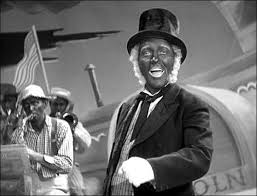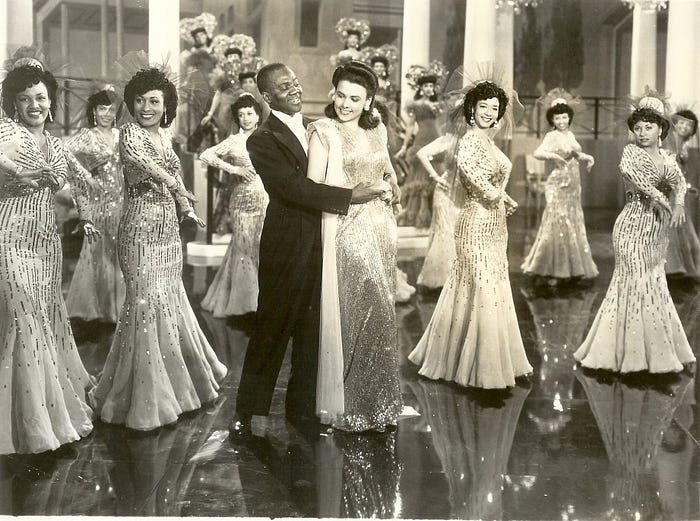Megyn and Bing and Blackface and Why You Can’t Whitewash the Past
Just before Christmas every December, I watch Holiday Inn, the 1942 movie with Fred Astaire, Bing Crosby, Virginia Dale and Marjorie Reynolds.
It’s sentimental and a little stilted here and there. Sometimes I like that in a movie. It has great dancing and songs. I always like that in a movie.

It also has something else. Crosby and Reynolds sing “Abraham,” a song honoring Abraham Lincoln’s birthday, in blackface.
That’s a pretty indelible image, which may be why it came to mind this week after NBC’s Megyn Kelly remarked that when she was growing up, it was okay to dress for Halloween in blackface (or whiteface) as long as you were “playing a character.”
Since Megyn Kelly wasn’t born until 1970, Bing Crosby’s Abraham Lincoln is probably not the character she was thinking of.
Still, her comment raises a question that remains relevant vis-à-vis Holiday Inn and a fistful of other movies right up through the middle of the 20th century: How should we treat something that offends us, but was, for better or worse, a widely accepted norm of the time in which it was created?
Most of us agree, I hope, that blackface today would be abhorrent. It conveys a degrading, dehumanizing stereotype of people with naturally dark skin. It conjures way too strong an image of dark-skinned people as happy clowns, put here for the entertainment of the smarter, lighter-skinned people who run the world and therefore deserve most of its riches.

I suspect it wasn’t commonly seen that way in 1942, which was only six years after Astaire himself put on blackface for the dance “Bojangles of Harlem” in the fine film Swing Time.

However jarring and appalling those scenes feel today, you need to add that Astaire’s intent was not to mock black dancer Bill Robinson. On the contrary, it was conceived as a tribute to a fellow dancer Astaire admired.
Absence of bad intent doesn’t override bad consequence. It still should be mentioned in the larger discussion.
Blackface at that point had been a minstrel and vaudeville show tradition for a century, since someone discovered that rubbing burnt cork on a performer’s face made for a striking visual.
So striking that it was routine for black as well as white performers to cork up. Perhaps ironically, Bill Robinson was one of the first black vaudeville dancers who refused to perform in blackface.
Yet there’s also this: In 1937, a year after Swing Time, Robinson wanted white dancer Geneva Sawyer for his partner in the film Café Metropole. The producers were afraid to feature a mixed-race couple dancing together. So Robinson suggested they film it with Sawyer in blackface, which they did — though the scenes were ultimately cut.
The only point here: Even a man who took the right stand, like Bill Robinson, felt blackface was, in some instances, an option. It was a different time.
By the 1940s that was less true, and while “Abraham” wasn’t the last blackface number ever, blackface was clearly making more people — read, paying customer — uneasy. Add in the fact that World War II served as a racial wakeup call throughout American culture, and blackface soon went the way of vaudeville itself.
I grew up in a very white suburb in the 1950s, and while my friends and I had the standard adolescent fascination with shock and outrage, I don’t recall blackface ever coming up.
The only encounter I can ever remember with blackface came in 1967, my sophomore year of college, when the chairman of the social committee and three of his friends put on blackface to promote an upcoming show by the Four Tops.
The reaction among the, again, mostly white student body was outrage. Apologies flew. The social committee chairman soon left school.
Point being, by 1967, three years before Megyn Kelly was born, I’m pretty sure blackface wasn’t widely viewed as acceptable even when you were playing a character.
Optimistically assuming that was true, and that it remains true today, that still leaves us with “Abraham,” in which the problem is compounded because one of composer Irving Berlin’s lyrics declares that Lincoln “set the darkie free.” Ouch.
And bam, another problematic door just flew open. “Abraham” isn’t the only song or piece of writing from the past that makes us wince in the present. Stephen Foster’s “My Old Kentucky Home” opens with the same word. Oscar Hammerstein’s “Old Man River” opened with a line containing the n-word. Perhaps the classic is Mark Twain’s Huckleberry Finn, riddled with the n-word.
Huckleberry Finn in most other ways is usually seen as resisting racism. Still, the word is there. What do you do with it?
When Paul Robeson did “Old Man River,” beautifully, he eventually just didn’t sing the n-word. Hammerstein at first was angry. Later he said he understood Robeson’s point.
It could be argued that in much the same way, the culture came around on the matter of blackface. For decades it was, “What’s the problem?” Finally it became, “Oh, yeah, that’s the problem.”
Why it took decades, or even minutes, belongs in a larger and even more depressing conversation about America and race.
And that still wouldn’t tell us whether Mark Twain or Stephen Foster, who were both American masters at their craft, should be rewritten to reflect cultural evolution.
It also doesn’t tell us whether TCM has been right to show Holiday Inn in its entirety, or whether AMC has been right to cut out the “Abraham” number.
Me, I watch Holiday Inn on a DVD with the complete film. That DVD also contains a colorized version. I have never watched the colorized version and I never will, because I like watching the film as it was originally conceived, the good and the bad.
“Abraham” is a bad part. It isn’t even a particularly good song. I’m just not sure that we move forward by pretending that song, and that America, never happened.








